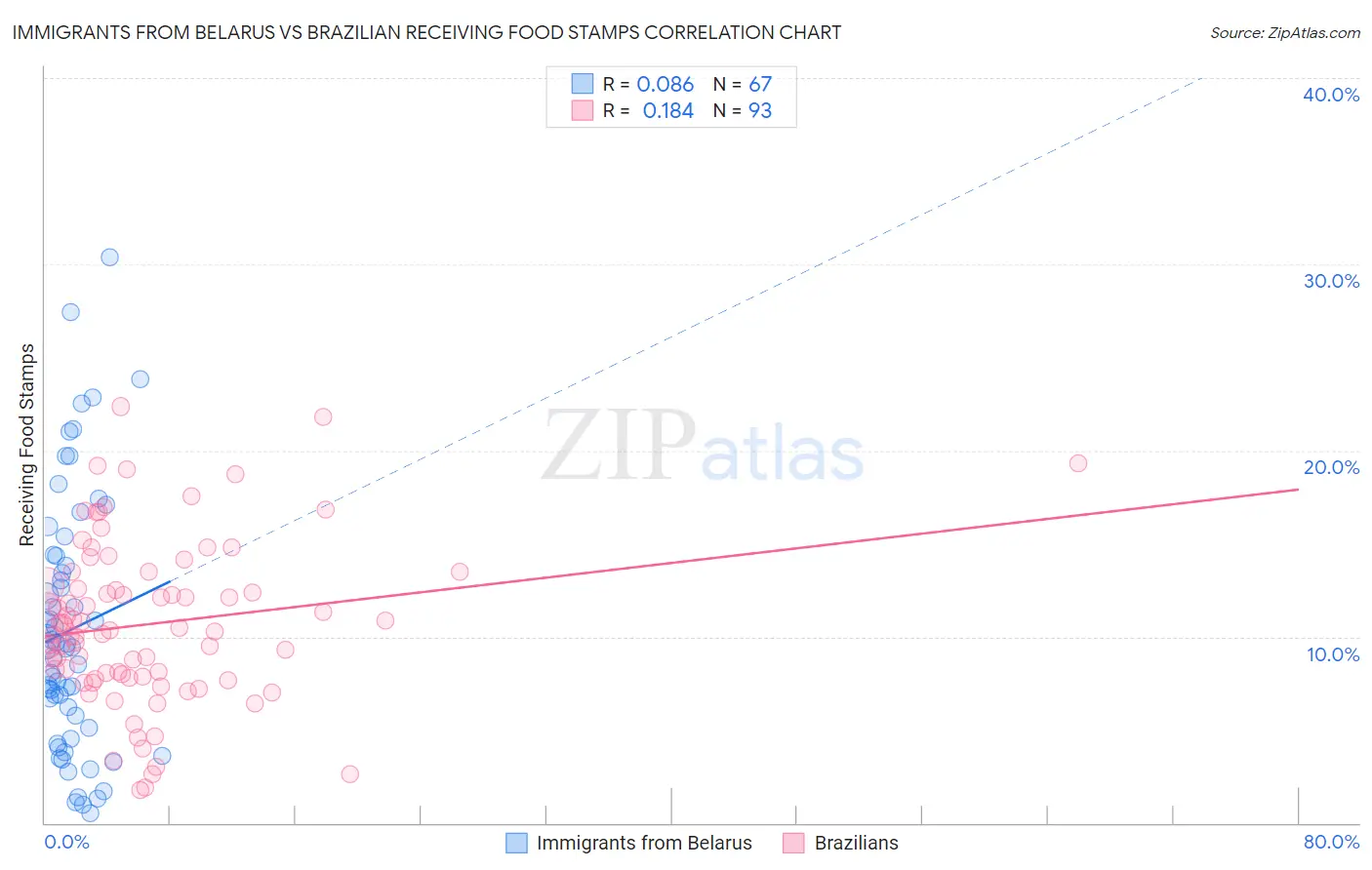Immigrants from Belarus vs Brazilian Receiving Food Stamps
COMPARE
Immigrants from Belarus
Brazilian
Receiving Food Stamps
Receiving Food Stamps Comparison
Immigrants from Belarus
Brazilians
11.5%
RECEIVING FOOD STAMPS
62.8/ 100
METRIC RATING
166th/ 347
METRIC RANK
11.1%
RECEIVING FOOD STAMPS
83.2/ 100
METRIC RATING
149th/ 347
METRIC RANK
Immigrants from Belarus vs Brazilian Receiving Food Stamps Correlation Chart
The statistical analysis conducted on geographies consisting of 149,924,892 people shows a slight positive correlation between the proportion of Immigrants from Belarus and percentage of population receiving government assistance and/or food stamps in the United States with a correlation coefficient (R) of 0.086 and weighted average of 11.5%. Similarly, the statistical analysis conducted on geographies consisting of 322,932,120 people shows a poor positive correlation between the proportion of Brazilians and percentage of population receiving government assistance and/or food stamps in the United States with a correlation coefficient (R) of 0.184 and weighted average of 11.1%, a difference of 4.0%.

Receiving Food Stamps Correlation Summary
| Measurement | Immigrants from Belarus | Brazilian |
| Minimum | 0.50% | 1.8% |
| Maximum | 30.4% | 22.4% |
| Range | 29.9% | 20.6% |
| Mean | 10.4% | 10.7% |
| Median | 9.3% | 10.3% |
| Interquartile 25% (IQ1) | 5.1% | 7.8% |
| Interquartile 75% (IQ3) | 14.3% | 13.1% |
| Interquartile Range (IQR) | 9.2% | 5.3% |
| Standard Deviation (Sample) | 6.8% | 4.4% |
| Standard Deviation (Population) | 6.8% | 4.3% |
Demographics Similar to Immigrants from Belarus and Brazilians by Receiving Food Stamps
In terms of receiving food stamps, the demographic groups most similar to Immigrants from Belarus are Arab (11.5%, a difference of 0.30%), Immigrants from Chile (11.5%, a difference of 0.35%), Kenyan (11.6%, a difference of 0.38%), Immigrants from Southern Europe (11.5%, a difference of 0.47%), and Alsatian (11.4%, a difference of 0.84%). Similarly, the demographic groups most similar to Brazilians are Immigrants from South Eastern Asia (11.1%, a difference of 0.020%), Soviet Union (11.1%, a difference of 0.020%), White/Caucasian (11.1%, a difference of 0.18%), Immigrants from Spain (11.1%, a difference of 0.38%), and Immigrants from Kazakhstan (11.1%, a difference of 0.39%).
| Demographics | Rating | Rank | Receiving Food Stamps |
| Whites/Caucasians | 83.9 /100 | #147 | Excellent 11.1% |
| Immigrants | South Eastern Asia | 83.3 /100 | #148 | Excellent 11.1% |
| Brazilians | 83.2 /100 | #149 | Excellent 11.1% |
| Soviet Union | 83.1 /100 | #150 | Excellent 11.1% |
| Immigrants | Spain | 81.7 /100 | #151 | Excellent 11.1% |
| Immigrants | Kazakhstan | 81.7 /100 | #152 | Excellent 11.1% |
| Lebanese | 81.6 /100 | #153 | Excellent 11.1% |
| Armenians | 81.4 /100 | #154 | Excellent 11.1% |
| Immigrants | Argentina | 80.4 /100 | #155 | Excellent 11.2% |
| Immigrants | Afghanistan | 75.6 /100 | #156 | Good 11.3% |
| Immigrants | Lebanon | 75.2 /100 | #157 | Good 11.3% |
| Immigrants | Bosnia and Herzegovina | 72.6 /100 | #158 | Good 11.3% |
| Immigrants | Oceania | 70.4 /100 | #159 | Good 11.4% |
| French Canadians | 69.5 /100 | #160 | Good 11.4% |
| Pennsylvania Germans | 68.4 /100 | #161 | Good 11.4% |
| Alsatians | 68.0 /100 | #162 | Good 11.4% |
| Immigrants | Southern Europe | 65.8 /100 | #163 | Good 11.5% |
| Immigrants | Chile | 65.0 /100 | #164 | Good 11.5% |
| Arabs | 64.7 /100 | #165 | Good 11.5% |
| Immigrants | Belarus | 62.8 /100 | #166 | Good 11.5% |
| Kenyans | 60.2 /100 | #167 | Good 11.6% |